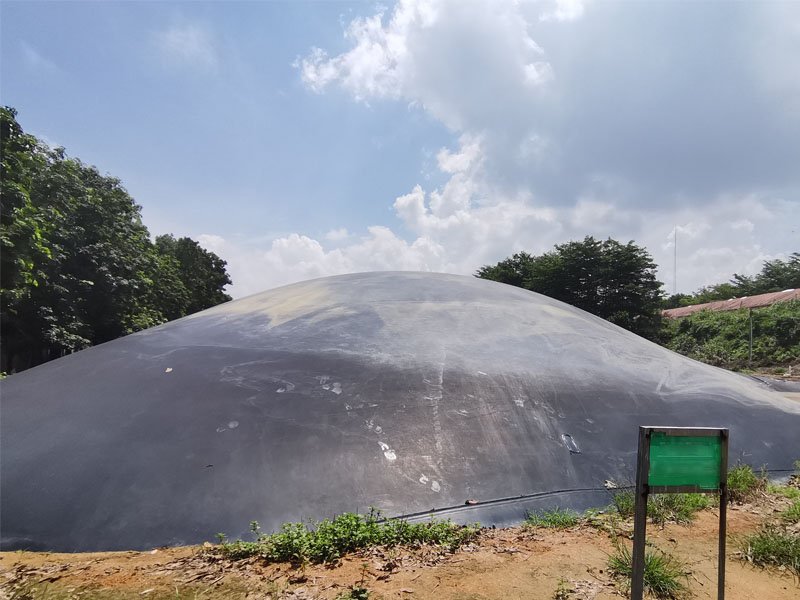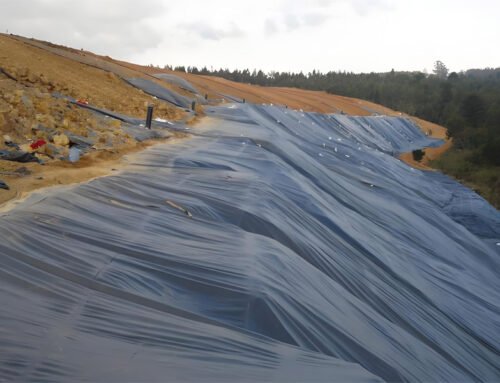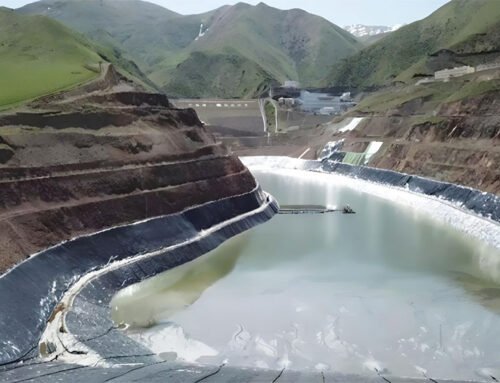A dam liner is a critical component in modern water containment systems, designed to prevent seepage and ensure the structural integrity of dams, reservoirs, and other water storage facilities. Typically made from durable materials like HDPE Geomembrane, these liners act as impermeable barriers, effectively controlling water flow and minimizing leakage. BPM Geomembrane, known for its high tensile strength, chemical resistance, and flexibility, has become a preferred choice for dam liners due to its ability to withstand harsh environmental conditions. Applications of dam liners extend beyond water storage; they are also used in irrigation systems, aquaculture, mining operations, and environmental protection projects. By incorporating advanced materials like BPM Geomembrane, engineers and project managers can achieve long-lasting, reliable solutions for water management and conservation challenges.
1.What Is Dam Liner?
Dam Liner is a geomembrane waterproof liner used in the construction of dams, reservoirs, ponds and other water storage structures. HDPE is a durable and flexible plastic material with strong resistance to puncture, UV and chemical, and corrosion. It is ideal for liner applications where water storage and environmental protection are critical.
HDPE Dam Liners are popular for their excellent tensile strength, puncture resistance and chemical resistance. They are also relatively easy to install and maintain. HDPE liners are usually manufactured in large rolls and welded or sewn together on site to form a continuous impermeable barrier to prevent water seepage.
1.1 Features of dam liner
- Excellent chemical resistance (corrosion resistance): It can resist various acid and alkali environments to ensure the safety of the place where it is used.
- Outstanding stress cracking resistance (environmental stress cracking resistance): HDPE dam liner has good stretchability and can maintain its own unbrokenness in various complex environments
- Lowest permeability: As a waterproof material, it can greatly play a waterproof role and ensure that there will be no water seepage
- Excellent UV resistance: Anti-UV ingredients will be added during the reproduction process to maximize the service life of HDPE dam liner
- Stable low temperature embrittlement resistance: HDPE dam liner has good stability and toughness. It can maintain its original characteristics in extreme environments.
1.2 Specifications of Dam liner
- Width:2m-10m
- Color:Black,Blue,Green and other colors
- Material:HDPE LDPE LLDPE


2. What Are The Advantages Of Dam Liner?
2.1 Dam Liner – Superior Impermeability:
Dam liners, especially those made from BPM Geomembrane, provide an excellent impermeable barrier, preventing water or chemical leakage. This is crucial for industrial applications such as mining tailings ponds, wastewater treatment, and chemical storage, where containment is critical.
2.2 Dam Liner – Exceptional Durability:
BPM Geomembrane is engineered to withstand harsh industrial environments, offering high resistance to punctures, UV radiation, and extreme weather conditions. This ensures long-term performance and reduces the need for frequent replacements.
2.3 Dam Liner – Chemical Resistance:
In industrial settings where exposure to corrosive chemicals is common, BPM Geomembrane liners excel due to their strong chemical resistance. This makes them ideal for use in chemical storage tanks, industrial effluent ponds, and hazardous waste containment.
2.4 Dam Liner – Flexibility and Adaptability:
BPM Geomembrane liners are highly flexible, allowing them to conform to uneven terrains and complex structures. This adaptability is essential for large-scale industrial projects, ensuring seamless installation and optimal coverage.
2.5 Dam Liner – Cost-Effectiveness:
The ease of installation and low maintenance requirements of BPM Geomembrane liners significantly reduce labor and operational costs. Their long lifespan further enhances cost savings over time.
2.6 Dam Liner – Environmental Protection:
By preventing leaks and seepage, BPM Geomembrane liners help protect surrounding soil and groundwater from contamination. This is particularly important in industrial projects involving hazardous materials or pollutants.
2.7 Dam Liner – Versatility in Applications:
BPM Geomembrane liners are suitable for a wide range of industrial uses, including water reservoirs, evaporation ponds, landfill liners, and oil and gas containment. Their versatility makes them a go-to solution for diverse industrial needs.
2.8 Dam Liner – High Tensile Strength:
The robust tensile strength of BPM Geomembrane ensures it can withstand significant stress and pressure, making it reliable for large-scale industrial containment systems.
By leveraging these advantages, BPM Geomembrane dam liners provide industrial projects with reliable, efficient, and sustainable solutions for water and chemical containment.
3. What Are The Applications Of Dam Liner?
Dam liners, particularly those made from BPM Geomembrane, play a vital role in a wide range of applications across various industries. Their versatility, durability, and impermeability make them an essential component in modern engineering and environmental projects. Below are some key applications where dam liners, especially BPM Geomembrane, are actively utilized:
3.1 Water Storage and Reservoirs:
Dam liners are widely used in the construction of water storage systems, such as reservoirs, ponds, and lakes. BPM Geomembrane ensures minimal water loss through seepage, making it ideal for agricultural irrigation, drinking water storage, and industrial water supply projects.
3.2 Mining and Tailings Ponds:
In the mining industry, dam liners are critical for containing tailings, slurry, and process water. BPM Geomembrane’s chemical resistance and durability make it a reliable choice for preventing the leakage of hazardous materials into the surrounding environment.
3.3 Wastewater Treatment:
Dam liners are essential in wastewater treatment plants to contain and manage industrial and municipal effluents. BPM Geomembrane’s impermeability ensures that contaminated water does not seep into the soil or groundwater, protecting ecosystems and public health.
3.4 Landfill Liners:
In waste management, dam liners are used as landfill liners to prevent leachate from contaminating the environment. BPM Geomembrane’s robust structure and chemical resistance make it highly effective in containing harmful substances and ensuring environmental compliance.
3.5 Aquaculture:
Dam liners are extensively used in fish and shrimp farming to create controlled water environments. BPM Geomembrane provides a safe and durable lining solution, ensuring optimal water quality and preventing leaks that could disrupt aquatic ecosystems.
3.6 Industrial Chemical Containment:
Industries dealing with hazardous chemicals rely on dam liners to safely store and manage these substances. BPM Geomembrane’s resistance to corrosive materials makes it a preferred choice for chemical storage tanks and secondary containment systems.
3.7 Oil and Gas Industry:
In the oil and gas sector, dam liners are used for containment of drilling fluids, produced water, and other byproducts. BPM Geomembrane’s high tensile strength and durability ensure reliable performance in demanding environments.
3.8 Evaporation Ponds:
Dam liners are employed in evaporation ponds for industries such as salt production, mining, and wastewater management. BPM Geomembrane’s UV resistance and impermeability make it ideal for these applications, ensuring efficient evaporation processes.
3.9 Environmental Remediation:
Dam liners are used in environmental cleanup projects to contain and isolate contaminated soil or water. BPM Geomembrane’s ability to withstand harsh conditions and prevent leakage makes it a key component in restoring polluted sites.
3.10 Hydropower Projects:
In hydropower generation, dam liners are used to line canals, reservoirs, and other water containment structures. BPM Geomembrane ensures efficient water management, minimizing losses and enhancing the overall performance of hydropower systems.
By incorporating BPM Geomembrane into these applications, industries and projects benefit from a reliable, long-lasting, and environmentally friendly solution for water and chemical containment. Its adaptability and superior performance make it a trusted choice across diverse sectors.


4. How Long Does A Dam Liner Last?
The lifespan of an dam liner varies. It depends on factors like thickness and material quality. Exposure conditions are also important, as are the chemicals it is exposed to. Dam liners are durable and can last for decades at least.
4.1 Factors Affecting Lifespan
Thickness: Dam liners range in thickness from 0.2mm-3.0mm, and dam liners above 0.5mm are relatively durable and resistant to mechanical damage
Exposure conditions: Prolonged outdoor exposure, exposure to extreme heat or cold, and physical stress can shorten the life of a liner. A protected liner will last longer than one that is exposed to the elements.
Chemical exposure: The chemicals in the liner, their strength, and how long they are present can weaken the material. This affects how long it will remain intact.
Installation: Proper installation is key to the life of the liner. No wrinkles or overstretching. This keeps it strong and durable, extending its service life.
Manufacturing quality: High-quality raw materials and manufacturing processes improve the overall performance and lifespan of the liner.
4.2 Expected Service Life
Typically, dam liners can last 50 years or more under normal landfill conditions. For other applications, such as pond liners or chemical storage, the service life may vary, but is usually in the range of several decades.
4.3 Maintenance and Monitoring
Regular inspection and maintenance of the liner is essential. It helps to detect problems early and resolve them. Shading from sunlight, good drainage, and frequent inspections for leaks or damage can greatly extend its service life.
5. Summary
Dam liner is strong and adaptable. It is durable, resistant to chemicals, acids, alkalis, etc., and can prevent leaks. It is used in waste management, water conservation, construction, agriculture and industry. As long as it is properly maintained, it can last for a long time and is cost-effective. To keep it in good working order, please install it correctly, maintain it regularly and repair any problems in time. BPM’s Dam liner can help you do a great job in your project. BPM is your best waterproofing partner.





